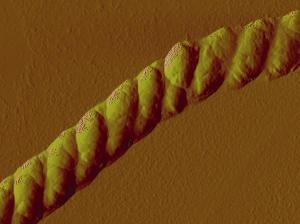
Berkeley Lab scientists have developed a nanoscale rope
Scientists at the U.S. Department of Energy’s Lawrence Berkeley National Laboratory (Berkeley Lab) have coaxed polymers to braid themselves into wispy nanoscale ropes that approach the structural complexity of biological materials.
Berkeley Lab scientists have developed a nanoscale rope that braids itself, as seen in this atomic force microscopy image of the structure at a resolution of one-millionth of a meter.
Their work is the latest development in the push to develop self-assembling nanoscale materials that mimic the intricacy and functionality of nature’s handiwork, but which are rugged enough to withstand harsh conditions such as heat and dryness.
Although still early in the development stage, their research could lead to new applications that combine the best of both worlds. Perhaps they’ll be used as scaffolds to guide the construction of nanoscale wires and other structures. Or perhaps they’ll be used to develop drug-delivery vehicles that target disease at the molecular scale, or to develop molecular sensors and sieve-like devices that separate molecules from one another.








